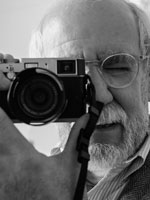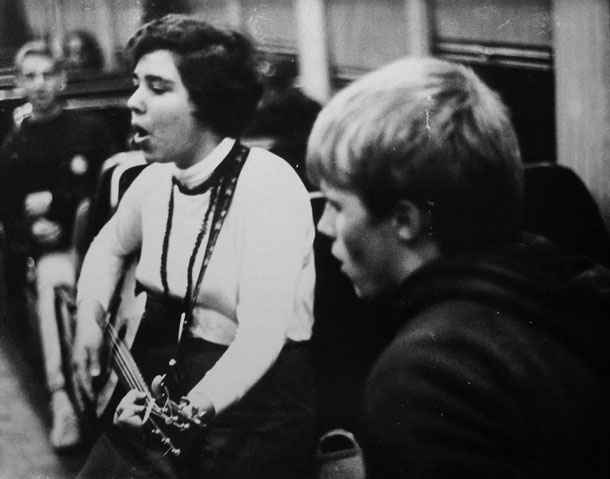
One of the few inviolate rules I force upon my documentary photo students is that they may not use Photoshop or other processing software to manipulate images beyond making the normal adjustments that would be made in a traditional darkroom — no adding anything to, or subtracting it from the image; no color manipulation beyond adjusting white balance; and, please God, no HDR, which, it goes without saying, is the acronym for Hideous Distortion of Reality. You may, I tell them, correct image contrast, dodge and burn — screen and multiply? — over- or underexposed areas and sharpen soft images, all with the aim of ending up with an image that accurately reflects what you actually saw at the instant you released the shutter. And then, invariably, comes The Black and White Question:
“I get all that,” a bold fool will pipe up, “so why is it okay to convert images to black and white? The world isn’t black and white.” But if you want to really see a person, if you want the viewer’s eyes to go to the subject’s face, their eyes, shoot them in black and white. Great photographers saw, or at least conveyed, the world in black, white and gray. They captured everything. But first things first:
My initial, facile, response usually is that black-and-white images are acceptable just as it always has been acceptable to shoot with different kinds of film. If pressed, I will point out that sensors capture images in monochrome, and we only end up with color images because a built in filter converts them — Google it if you don’t believe me.
But neither of those answers gets to the heart of the matter, and neither gets even close to why I convert to black and white a good 90% of images I shoot for myself:
I convert images to black and white because I grew up shooting Kodak Tri-X black-and-white film. I convert images to black and white because all the photographers whose work shaped my vision shot, or still shoot, in black and white ‹ most shooting Tri-X. I convert images to black and white because the vast majority of important documentary and street photography has been black-and-white photography. I convert images to black and white because I believe that monochromatic images do a better job of conveying what a photograph is about, rather than what it is of.
A half century ago, when photography first grabbed me by the throat and heart, two things were true: the photographers whose work most moved me did so with black-and-white images; and, shooting color was a real bitch — the learning curve was extremely steep, with expenses to match. Color temperatures? Filters? Time of day? Shadows? Cloud cover? Custom printing? Forget about it. Just grab a roll of Plus-X or Tri-X and go take pictures; to say nothing of the fact that 100 foot rolls of those films were cheaper than dirt, and the cost of shooting could be further reduced by rolling your own — rolls of film. So there was, I will admit, a laziness/cheapness attraction factor to shooting black and white.

But far, far more important than that, for a young photographer discovering and exploring the medium in the late 1950s and 60s were a hand-full of names: Henri Cartier-Bresson, W. Eugene Smith, Bruce Davidson, Robert Frank, Robert Capa, Danny Lyon, Helen Levitt and, especially for me, Ken Heyman. And if you are vaguely curious about what ultimately influence the content of my work, search for a battered copy of Hyman’s sublime book Willie.
All of these photographers saw, or at least conveyed, the world in black, white, and gray. More accurately, they captured the entire, brilliantly colored world in infinite shades of gray. Think you need color to shoot landscapes? Consider the work of Ansel Adams — I’m no fan of his work (a subject for another day), but he certainly could capture a blue sky, green forests, pale yellow desert sands, and everything else in the natural world with those shades of gray — and do it better than most people using color film.
So withTri-X and Plus-X, first in a shockingly cheap, used Leica IIIc with a Canon Serenar 50mm 1.8 lens, then in an F2.8 Rollei my father loaned me, and eventually in a Honeywell Pentax with a 50 1.8 and a Schneider 135 F3.5, I began documenting the world around me. I shot at summer camp, I shot at school, I started interning for newspapers, I covered the historic March on Washington for Jobs and Freedom — and all with black-and-white film I could develop in the bathroom.
But why 50 years later — okay, it’s more like 55 years later, am I still a black-and-white photographer, at least a good 90% of the time when it comes to my own work? After all, these days any DigiMom can master color — put the Rebel on P and depress the shutter release. For that matter, anyone with a cell phone can shoot more accurate color than a lot of the big name photographers working for LIFE in the 1950s.
But that misses a point. The question shouldn’t be, “Why not shoot color?” Rather, it should be, “Why shoot color?” And the answer to that question is that it makes sense to shoot color when color is either the entire subject of the photograph, or a major part of it. Go spend some time with the work of Alex Webb or William Egglelston. Look at Joel Meyerowitz‘s Cape Light work — and you will see brilliant photography in which the color is, in and of itself, either the sole subject or the primary subject of the images.
Conversely, look at the work of Cartier-Bresson and you’ll see work in which shapes, shadows and the geometric arrangements of the elements in the image are the subject of the image: color would distract from the subject.
And that brings us to the answer to the question I first posed — why do I still shoot black and white most of the time? I shoot black and white because color distracts from my subjects, most of which are people and their interaction with their world. Do I ever shoot with color? Of course — if the subject demands it. For example, each year I photograph a small number of weddings. During the first half of the day, when the bride and family members are getting ready, right through the ceremony, I make a limited number of color images, to document what the colors were, but most of what I shoot is black and white. After all, the day is about people, not colors. Wedding dresses are white. But in the evening, when a wedding turns into a party, I turn to color, because for me — and that is who I photograph for — parties are about color.
Also, I should point out every image I make is initially created in color; I wouldn’t think of shooting camera-created black and white JPGs, nor do I have any interest in a monochrome-only camera. After all, one of the real benefits of the digital revolution is that we have the ability to have every “film type,” and every ISO, available for every shot. I love having the ability after the shoot to reconsider my initial take on a scene — and shooting in color gives me that.
As Ted Grant, who is justifiably known as the father of modern Canadian photojournalism — no, that is not an oxymoron — likes to tell students, “When you shoot a person in color, you see their clothes; when you shoot them in black and white, you see their souls.”
I will admit that talk of souls makes me a bit itchy, but Grant really depressed the shutter release on that one: if you want to really see a person, if you want the viewer’s eyes to go to the subject’s face, their eyes, shoot them in black and white.
If you want to capture a child at play, and really see the child, shoot them in black and white.
If you want to capture a couple in a café, a tired commuter on a subway late at night, a cop on the beat, then do it with black and white.
If you don’t, you’ll end up with frame full of conflicting, distracting colors, and they are what will grab the viewer’s attention.


